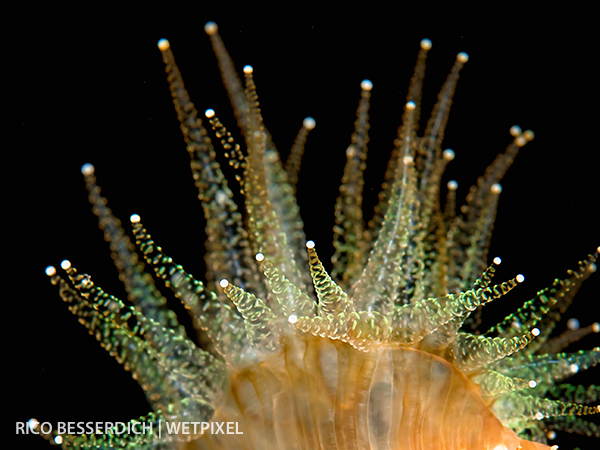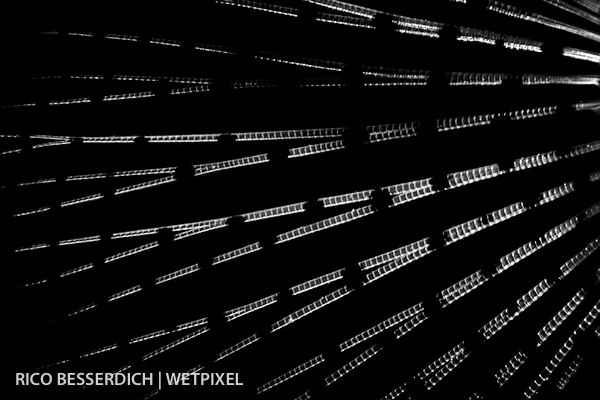Ask the Pros: Macro Part 1

Kevin Palmer
Kevin Palmer has been a photographer for over 25 years. His work has won international awards, appears regularly in numerous publications and has been featured in several years of calendars distributed internationally.
1. What is your favorite macro lens (and why)?
Every good macro lens has its moments where it becomes a “fave”. When shooting crop-sensor DSLRs, the current Nikon 105 VR or Canon 100 IS are definitely the bees knees for reach, image quality and super macro potential – this is perhaps an ideal balance for small fish portraits and smaller close ups. While they are also very good lenses on full frame cameras, it is easy to wish for something with a bit better framing and reach at times. The Sigma 150 really fills that gap nicely. With the excellent AF function on the current crop of pro DSLRs, it is amazing how well this lens performs and locks focus – it can be addicting fun once you are comfortable with it’s behavior.
2. Cropped or full frame camera for macro?
I guess this would be if you had the choice of either. I can be happy with either, but the smaller the stuff I want to shoot is, the more I love crop sensors with good resolution. At ISO 100 (typical for macro), it is very difficult to tell the IQ difference between high end cropped and full frame sensor images of the same subject… but the crop sensor shot is generally easier to get.
3. Do you use manual or auto focus? If it is the latter, what sort of autofocus mode do you tend to use?
Manual focus is the ideal tool for super close work, but having been so spoiled with the quality of modern AF, a hybrid technique of thumb focus and “lock and rock” (adjusting the housing to fine tune focus) actually performs quite well and allows a lot of flexibility for the type of subject being focused on. For super macro work an adjustable single point focus is ideal. For fast moving fish portraits, some of the new modes like adjustable group focus can be very successful

4. How do you light your subjects? One strobe/light or two (or more)?
Two strobes allow so much flexibility if mounted properly that the potential effects are near endless. While having two strobes solves a lot of the harsh shadow problems we often have with one strobe, it also allows me to dial a little shadow back in by adjusting strobe power differently. I feel this added definition and dimension really breathes life into the shot. Reverting back to one strobe for special effect is only a strobe switch away.
5. Do you use snoots or other devices to control your lighting?
Not much – this could well be a lack of patience! There are some great applications for snoots without a doubt. Sometimes just using my hand like barn doors in studio lighting can do the trick. Off camera lighting with an Inon strobe with its extremely sensitive optical sensor can also do wonders with backlighting subjects and other interesting techniques.
6. Do you prefer a black or colored background? Do you tend to shoot for bokeh-style diffuse soft focus backgrounds?
Both – they are completely different moods and impact. Some backgrounds call out for one style more than another and sometimes they look equally nice, albeit different, on the same subject. Shallow depth of field/soft backgrounds are certainly the photographers friend in many mucky locations, and to my eye, often looks more artistic. But ultimately every situation has to be assessed for a “best look”.

7. What is your favorite macro subject? Any tips on the best way to shoot them?
Personally I relish hunting small reef fish that, when isolated from the bustling ecosystem, explode from the image with incredible vibrancy and detail that is normally lost in the riotous activity. This generally requires a longer macro lens – 100-150mm or even 180mm to be able to isolate a generally shy subject. Auto-focus is essential as is patience. Start with easy and impressive subjects like male anthias before moving on to the tough subjects like pygmy angels and flasher wrasse.
8. If macro tends to be a technical discipline, how do you shoot also shot creatively? What makes for a unique macro image/video?
The technical aspects of macro are straight forward and easy – buy the right gear for the job, spend a little time learning the essentials of focus, lighting and exposure in a book or workshop - then go diving where you are likely to find good subjects. But the vast majority of what makes for really great macro photos as opposed to just good ID shots is more nuanced and requires a bit of dance between reef denizen and photographer. One can think of it as speed-dating with your subject. What is the most distinctive feature and how can you show it? Does it have a good side? How will someone be able to tell what it is? Does it have eyes? Is the background attractive or does it tell a story? Can I get under it for an upward angle? Is it moving somewhere more attractive? Does it have an activity or expression that belies a personality? If I was going to have stronger light on one side – which should it be? Do I want to highlight its translucence? Is negative space positive? At the end of the dive, megapixels are cheap, experimenting where possible (and where appropriate with the animal) will lead to discoveries both wonderful and awful. If you can successfully answer a reasonable number the above questions with your image, it will probably prove unique and appealing. An artistic touch comes faster to some than others, but it is within reach of everyone.
9. Do you manage to sell any macro images or footage?
Yes – macro abstracts do well with designers. In editorial as well, but they are often relegated to “supporting role” images for a destination as opposed to the more prominent reef scenic with strategic diver placement or a dramatic big animal images.

Rico Besserdich
Rico is a professional underwater photographer, artist & journalist. He has been involved in photography since 1978 and became specialized in underwater photography in 2001. 1. What is your favorite macro lens (and why)?
Shooting with a crop camera, my macro lens of choice is the CANON EF-S 60mm Macro F/2.8.
I like its small size and compared to a 100 or 105mm Macro lens the 60mm provides a bit more flexibility as it works fine for fish portraits, patterns as well.

2. Cropped or full frame camera for macro? I guess this would be if you had the choice of either.
Crop camera. Not a question of choice, its more about to work with what’s on the table.
3. Do you use manual or auto focus? If it is the latter, what sort of autofocus mode do you tend to use?
I’ve tried manual focus years ago but soon found out that the autofocus works more reliable than the manual focus. Focus control of my underwater housing missed to have the sensitivity I see as crucial for manual focussing.
I most of the times use the “One Shot” autofocus mode unless I need to track swimming macro critters. In such cases I switch to “AI Servo”.
I love to work with selective focus, so I often set my focus points manually.

4. How do you light your subjects? One strobe/light or two (or more)?
For macro photography I personally see just one strobe as totally sufficient and often have my second strobe switched off.

5. Do you use snoots or other devices to control your lighting?
My first and last snoot is still drifting around (without me!) in the Red Sea for 3 years now and I don’t miss it at all! I do all my lightning by just altering strobe positions and that works fine for me.
6. Do you prefer a black or colored background? Do you tend to shoot for bokeh-style diffuse soft focus backgrounds?
Despite the fact that those black background uw images do still have commercial value and do attract beholders, I for myself now prefer colored backgrounds with pleasing Bokeh. I do this for many years already and I like that style. Instead of black background I sometimes try to work on the opposite: very bright or even white backgrounds, inspired by traditional High-Key photography.

7. What is your favorite macro subject? Any tips on the best way to shoot them?
For my own photography I like to extract specific details of anything interesting I see underwater. Animals, plants, corals, fish or just stones: I really don’t care. I have to confess that I am not a “critter hunter”.
8. If macro tends to be a technical discipline, how do you shoot also shot creatively? What makes for a unique macro image/video?
In my humble opinion there is no ‘golden key’ for creative photography (macro or not) that works for everyone. Creativity evolves of the way a photographer see a subject or scene and of from his/her personal attempt to express this with an photographed image. The usage of special equipment used I personally would not always consider creativity, but sometimes those little extra tools can help to realize the photographer’s intention of course.
What makes for a unique macro image/video? Well, this question actually includes the answer already. Make it unique! Uniqueness is the opposite of re-producing what others already did before.

9. Do you manage to sell any macro images or footage?
Yes of course. But my wide-angle shots are selling better ;-)
Page 1: Imran Ahmad, Allison Vitsky Sallmon and Andy Sallmon, Steve Jones.
Page 2: Douglas Seifert and David Fleetham.
Page 3: Kevin Palmer, Rico Besserdich.
Page 4: Jean Bruneau, Chris Parsons.